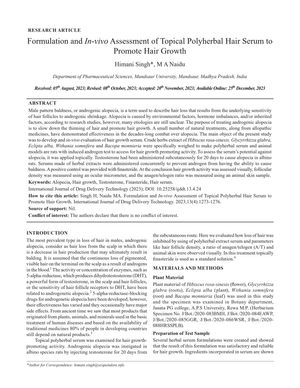TLDR The polyherbal hair serum helped prevent hair loss and improved hair growth better than the usual treatment.
The study developed a polyherbal hair serum containing extracts from five different plants and tested its effectiveness on male Wistar albino rats with testosterone-induced alopecia. The serum was found to prevent hair loss, increase the number of hair follicles in the growth phase, and improve hair texture, outperforming the conventional treatment, finasteride. The experiment involved six rats per group over a 21-day period, suggesting that the serum could be a promising treatment for androgenic alopecia.

Micro-needling with growth factors and minoxidil improved hair growth in a balding man.
 5 citations
,
January 2015 in “Journal of clinical & experimental dermatology research”
5 citations
,
January 2015 in “Journal of clinical & experimental dermatology research” MorrF improves hair growth better than minoxidil alone.
August 2014 in “Journal of drug discovery and therapeutics” Topical minoxidil and oral finasteride can help regrow hair in androgenetic alopecia.
January 2007 in “Strait Pharmaceutical Journal” Water-soluble minoxidil effectively promoted hair growth in mice.
 March 2005 in “Journal of The American Academy of Dermatology”
March 2005 in “Journal of The American Academy of Dermatology” Two cosmetic lotions improved hair growth and had better cosmetic effects than 2% minoxidil.
35 citations
,
January 1990 in “PubMed” Cyclosporin A boosts hair growth in nude mice, but minoxidil does not.
16 citations
,
July 1988 in “International Journal of Dermatology” The 2% minoxidil solution is safe and effective for treating male pattern baldness.
12 citations
,
May 1988 in “Journal of the American Academy of Dermatology” Both 2% minoxidil gel and solution effectively increase hair growth in men with early baldness.
 57 citations
,
July 1987 in “Journal of The American Academy of Dermatology”
57 citations
,
July 1987 in “Journal of The American Academy of Dermatology” Stopping minoxidil treatment resumes balding; continuous use needed for results.




